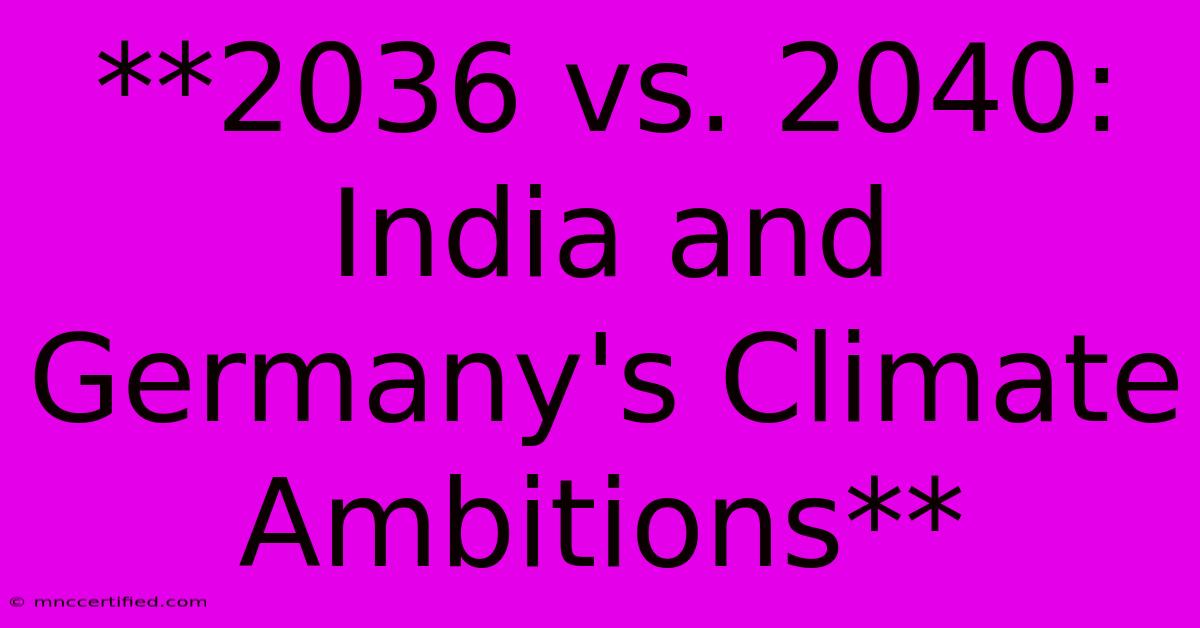**2036 Vs. 2040: India And Germany's Climate Ambitions**

Table of Contents
2036 vs. 2040: India and Germany's Climate Ambitions
The global fight against climate change is a complex dance of ambitious goals and diverse timelines. Two major players in this dance, India and Germany, have outlined distinct approaches to achieving carbon neutrality. While Germany aims for 2045, India has set its sights on 2070. This divergence in climate ambition raises questions about the effectiveness of each strategy and their potential impact on the global climate.
Germany's Ambitious 2045 Target
Germany, a pioneer in renewable energy, has committed to becoming carbon neutral by 2045. This bold target is driven by a strong political will and a belief in the urgent need to tackle climate change. The country has already made significant strides in transitioning to a green economy, with renewable energy sources now providing a substantial portion of its electricity.
Key Strategies:
- Accelerated Phase-out of Coal: Germany is phasing out coal-fired power plants, aiming to achieve a complete shutdown by 2038.
- Investment in Renewable Energy: Germany is investing heavily in solar, wind, and other renewable energy sources, aiming for a substantial increase in their share of the energy mix.
- Energy Efficiency Measures: Germany has implemented numerous energy efficiency programs for buildings, transportation, and industry, aiming to reduce energy consumption and carbon emissions.
India's 2070 Vision: A Gradual Transition
India, with its vast population and rapid economic growth, has adopted a more gradual approach to achieving carbon neutrality. The country has set a target of achieving net-zero emissions by 2070, recognizing the significant challenges associated with transitioning its energy infrastructure.
Key Strategies:
- Focus on Sustainable Development: India emphasizes sustainable development practices, aiming to achieve economic growth while minimizing environmental impact.
- Renewable Energy Expansion: India is aggressively expanding its renewable energy capacity, with ambitious targets for solar and wind power installations.
- Technology and Innovation: India aims to leverage technology and innovation to achieve its climate goals, including advancements in energy storage, carbon capture, and green hydrogen.
Comparing the Approaches: Pros and Cons
Germany's 2045 Target:
Pros:
- Stronger signal of commitment: The ambitious target sends a clear message to the world about Germany's commitment to climate action.
- Accelerated technological advancement: The rapid transition necessitates innovation and drives technological development in the renewable energy sector.
- Potential for global leadership: Germany's ambitious goal can inspire other countries to adopt similar targets and accelerate global climate action.
Cons:
- Higher economic costs: The rapid transition could impose significant economic costs, potentially impacting industries and employment.
- Potential for social unrest: Rapid changes in energy systems can lead to social unrest, especially if communities feel left behind in the transition.
- Technological feasibility: Achieving net-zero emissions by 2045 may require breakthroughs in technologies that are not yet fully developed.
India's 2070 Target:
Pros:
- More realistic timeline: The gradual transition allows India to prioritize economic development and address the challenges of providing energy access to its population.
- Reduced economic disruption: The slower pace of change can minimize economic disruptions and social unrest.
- Focus on sustainable development: India's strategy prioritizes sustainable development, ensuring that economic growth is balanced with environmental protection.
Cons:
- Weaker signal of commitment: The later target may be perceived as less urgent and could lead to delays in global climate action.
- Potential for missed opportunities: Delaying the transition could miss opportunities for innovation and technological advancement in the renewable energy sector.
- Potential for increased emissions: The slower transition could result in higher emissions in the short term, exacerbating the climate crisis.
The Importance of Collaboration
Ultimately, achieving global climate goals requires a concerted effort from all countries, regardless of their individual targets. Both India and Germany have a crucial role to play in this fight. While their timelines may differ, the need for collaboration on technology, knowledge sharing, and international funding is paramount.
- Technology Transfer: Germany, with its advanced renewable energy technology, can assist India in developing its renewable energy infrastructure.
- Financial Assistance: Developed countries like Germany can provide financial assistance to developing countries like India to support their transition to a green economy.
- Joint Research & Development: Collaboration on research and development of new technologies can accelerate the pace of innovation and create solutions for a sustainable future.
The journey to carbon neutrality is a marathon, not a sprint. Whether it's 2036, 2040, or 2070, the ultimate goal is a sustainable future for all. This requires cooperation, shared knowledge, and a commitment to addressing the global challenge of climate change.

Thank you for visiting our website wich cover about **2036 Vs. 2040: India And Germany's Climate Ambitions**. We hope the information provided has been useful to you. Feel free to contact us if you have any questions or need further assistance. See you next time and dont miss to bookmark.
Featured Posts
-
Are Gutters Covered By Home Insurance
Nov 10, 2024
-
Bear River Insurance West Jordan Utah
Nov 10, 2024
-
Arcane Season 2 Episode 4 Release Schedule
Nov 10, 2024
-
Abc Insurance Agencies New Orleans La
Nov 10, 2024
-
Cambridge Investment Research Careers
Nov 10, 2024